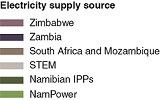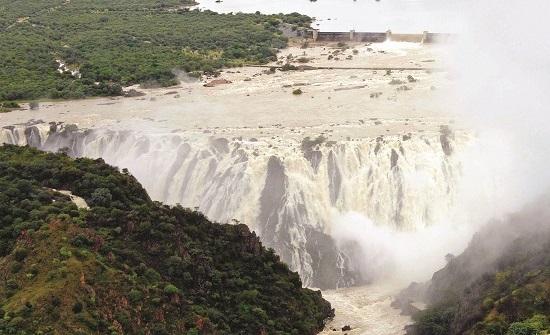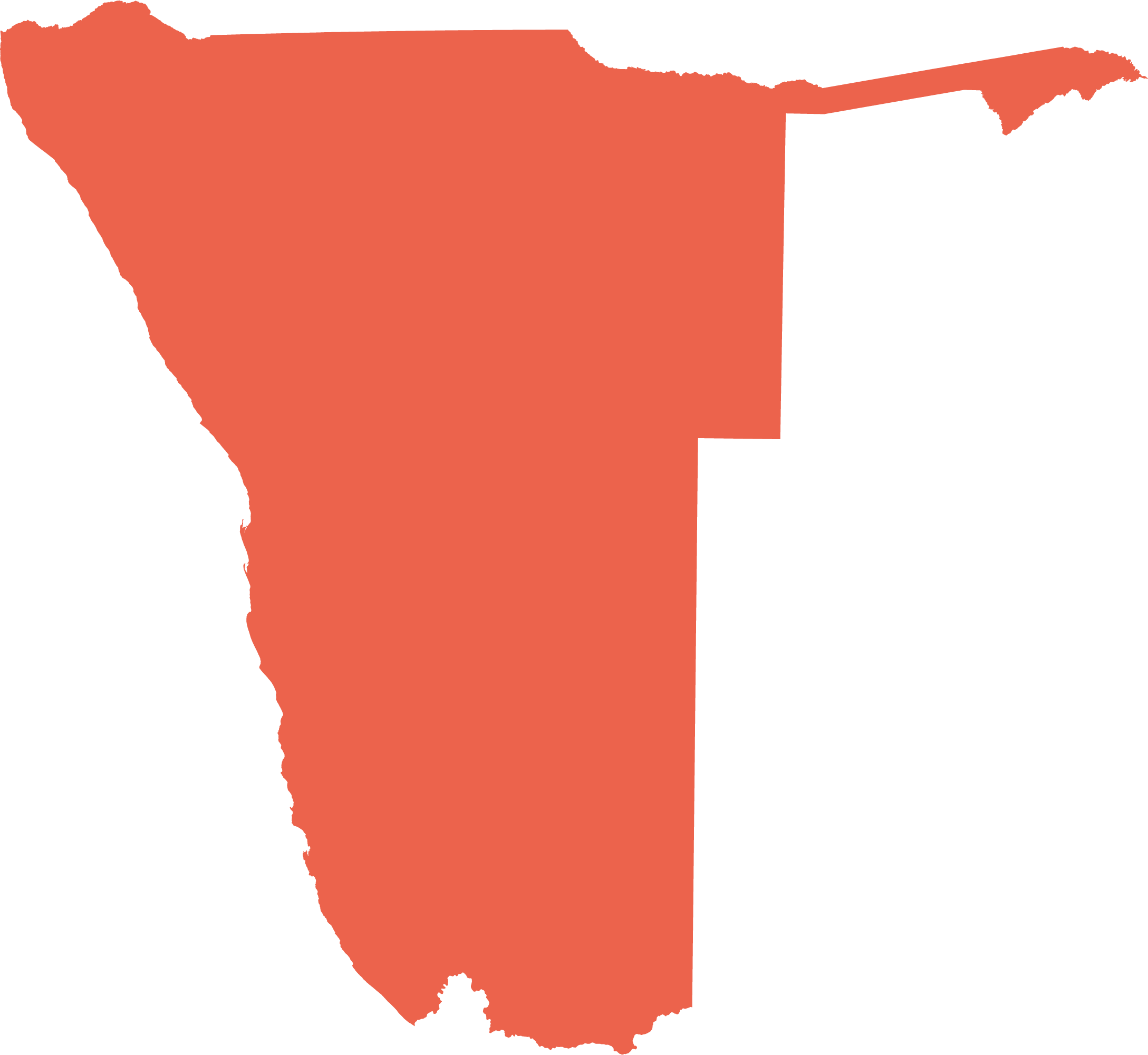Energy
A thriving economy requires a dependable and secure supply of power, and Namibia is endowed with a variety of primary energy resources – renewable solar, wind, biomass, hydro, geothermal and tidal, and non-renewable oil, coal, natural gas, natural uranium and thorium. Such resources are forms of energy that can be converted by engineering processes to produce a secondary energy, such as electricity.
10.20 Proportions of energy types used to meet Namibia's needs, 201923

Namibia's national energy mix was dominated by non-renewable sources such as diesel, petrol and heavy fuel oil in 2019. Liquid diesel, petrol and other liquids made up about two-thirds of the energy used by Namibians. The remaining third was electricity and plant biomass.
All these liquids and lubricants, and a sizeable fraction of Namibia's electricity requirements were purchased from regional suppliers (figure 10.22). Coal was also imported and mainly used to generate electricity, and for heat production in commerce and industry. Only about 23 per cent of the country's total energy requirements came from within Namibia in 2019, of which biomass contributed most.
10.21 Major suppliers of electricity, 2009/10–2018/1924


Namibia's electricity use increased from 3.8 terawatt-hours in 2009/10 to 4.8 in 2017/18, and decreased to 4.4 terawatthours in 2018/19. Historically, electricity has been provided by five sources: NamPower (Namibia Power Corporation), South Africa's Eskom, and Mozambique, Zambia and Zimbabwe. Two other sources became available more recently: the short-term energy market (STEM) offered by the Southern African Power Pool, and independent power producers (IPPs) in Namibia. Capacity through the short-term energy market has been drawn on since 2014/15; it can be procured within a day's notice, in contrast to the longer contracts with other suppliers that can extend over many years. The independent power producers in Namibia produce electricity using renewable solar and wind power.
10.22 Hydropower electricity generated and water flow at Ruacana, 1999–201925

Hydropower generation and water flow are strongly correlated. In 2018/19, NamPower's Ruacana power plant, which is a runof-river system on the Kunene River, contributed 26 per cent of all the electricity used in Namibia. The electricity supplied by Ruacana not only uses a renewable source of energy, but costs Namibia little in comparison to imported electricity. The amount of hydropower that Ruacana generates is, however, likely to decrease in the future as increasing volumes of upstream water are used in Angola. There is, however, potential to generate more electricity along the Fish River at the Neckartal Dam.

Photo: H Denker

Photo: J Mendelsohn
In recent years, about 70 per cent of the electricity used in Namibia has been imported with most of the balance being produced by hydropower generated at Ruacana Falls. Up until 2016, Ruacana contributed 95 per cent of Namibia's local production for the national grid, with the balance produced by generators fired by imported coal and heavy fuel oil. Since 2016, more and more electricity has been added to the grid by local solar and wind generators. The flow of water at Ruacana in the Kunene River varies between very high discharges (first photo, 2011) and thin streams at other times (second photo, 2017). Even though Ruacana's generators are on Namibian soil, in a sense the hydropower of the river's water is also imported.
10.23 Annual uranium concentrate exports, 1976–201826

Rössing Uranium Mine, having opened in 1976, is the longest running uranium mine in Namibia. Three other mines have contributed to the country's uranium production since 2007 – Langer Heinrich, Trekkopje and Husab. Namibia is one of the world's largest uranium producers, contributing 4–8 per cent of the world's annual production. If the country's uranium exports are expressed in terms of their potential to generate electricity, Namibia is a significant net exporter of energy. Namibia, however, does not produce nuclear power.
10.24 Power stations, transmission lines and main substations27

Much of Namibia's electricity is distributed along a backbone of transmisssion lines that run diagonally across the country: from the southwest carrying electricity from South Africa and from Ruacana in the northwest. Other major transmission lines link the central coast and northeast to this back-bone. Major lines also supply central-northern Namibia and Skorpion Zinc Mine at Rosh Pinah.
The publicly owned electricity utility, Namibia Power Corporation (better known as NamPower), owns and operates the transmission networks connecting regional markets to Namibia, and facilitates the trade of electricity between suppliers and consumers. NamPower's installed generating capacity was 489.5 megawatts in 2019. Three regional electricity distribution companies, Northern (NORED), Central North (CENORED) and Erongo (Erongo RED), and various local and regional authorities and others distribute and supply electricity to end users. The electricity sector has a well-developed operational and governance framework and is regulated by the Electricity Control Board.
10.25 Major users of electricity, 2009/10–2018/1928


Over this period, four main users purchased electricity from NamPower. Two industries have had noteworthy electricity requirements: Skorpion Zinc Mine, which on average purchased 14.1 per cent of NamPower's supply, and the irrigation sector and other consumers along the Orange River, which purchased 3.5 per cent. Other customers in Namibia purchased 80.0 per cent of NamPower's electricity, while 2.4 per cent was exported to out-of-country customers (mainly Angola).

Photo: J Pallett
Namibia's development is critically impeded by its low electrification rate. In 2019, less than half of Namibia's households – and only 19 per cent of rural households – had access to electricity. Not having access to electricity decouples Namibians from economic development and personal upliftment. For example, having lights, refrigeration, cooked meals, regular access to information or other uses of energy becomes more difficult without access to electricity.
Grid electricity provided by power lines such as these cannot be supplied cost effectively to every household in a country as large and sparsely populated as Namibia. However, recent advances in energy technologies have triggered rapid price reductions of solar photovoltaic modules and stand-alone electricity storage systems. These enable partial, or even complete, self-reliance on electricity generation. A large variety of decentralised electricity supply options provide reliable power for several hours per day, or even continuously. New funding methods enable consumers to select specific services that meet their energy needs and financial means.
Furthermore, grid-supplied services are rapidly diversifying, with end users now able to bank self-generated electricity in the grid for later use. Smart systems manage the timing and extent of industrial and household consumption, also benefiting from increasingly efficient electrical appliances. Hybrid power systems often combine several supply options with storage.

